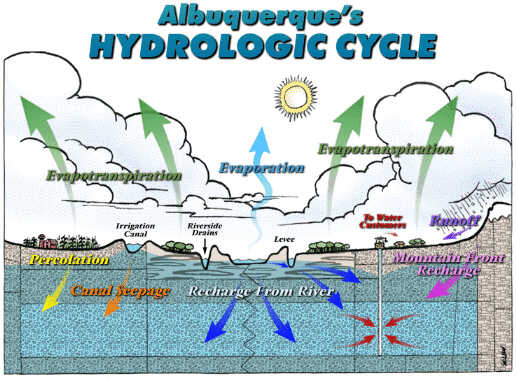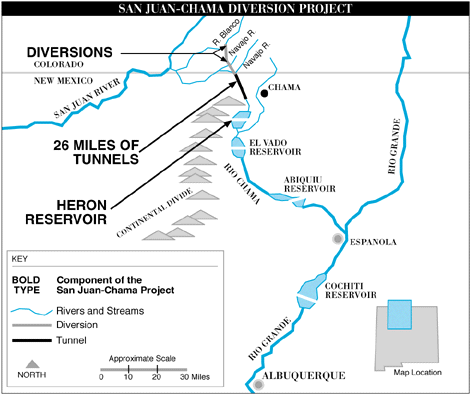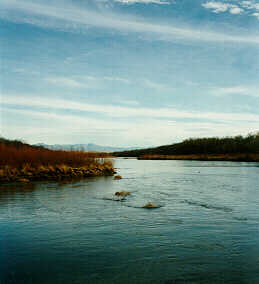Earth's hydrologic cycle is the process by which nature circulates water from the oceans through the atmosphere and returns it overland and underground back to the sea. Radiation from the sun evaporates ocean water into the atmosphere. This water vapor rises and collects, forming clouds that are transported by moving air masses. Under the proper conditions, the cloud moisture condenses and falls back to earth as rain, hail, sleet, or snow---common forms of precipitation. Precipitation that falls on land areas is dispersed in several ways. The greater part is temporarily retained in the topsoil near where it falls and eventually returned to the atmosphere by evaporation and plant transpiration. A portion of the water finds its way over and through the soil surface to streams. Other water penetrates the soil surface, becoming ground water. Under the influence of gravity, both surface stream flow and ground water move downhill and may eventually discharge into the oceans. Substantial quantities of surface and underground water do return to the atmosphere by evaporation and transpiration before reaching the ocean. The amount of time required to complete the cycle may be anywhere from a few hours to many centuries. The forces that motivate this process include solar radiation, gravity, molecular attractions, and capillarity.

|
Ground water is currently the sole source of water supply for the City of Albuquerque. Water beneath the Earth's surface is stored in and flows through dirt, sand, and porous, fractured rock. This sponge-like formation is referred to as an aquifer. The Albuquerque Aquifer extends from Cochiti at the north to Soccoro at the south and from Tijeras Canyon on the east to the Rio Puerco on the west. This aquifer is located in a region considered high desert with an average annual rainfall of less than 9 inches. Only eight to ten percent of precipitation penetrates the soil surface moving downward into the aquifer. Snow melt from mountains in Colorado and northern New Mexico provides most of the water in the aquifer by making its way to the Rio Grande, then penetrating the river bed to become part of the underground water system. Unfortunately, people in Albuquerque are currently using more water per capita than many other major cities in the southwest -- and the water from the aquifer is not being replenished as quickly as it is being pumped out.
The Albuquerque Bernalillo County Water Utility Authority (ABCWUA) owns and operates the water and wastewater systems that serve a 2006 population of approximately 525,000. Most of these customers live within the City of Albuquerque while around 10% live in the unincorporated area. The city operates 93 water wells, distributed over 200 square miles, that raise the ground water to the land surface. While the depth to the water table (the uppermost level of ground water) in the Albuquerque area varies between 15 and 1000 feet, the city system taps the aquifer with wells as deep as 1,800 feet. All but a few of the wells are driven by electric motors. The rest are driven by engines fueled by diesel or natural gas. Several of these wells have the capability to pump as much as 3,000 gallons per minute, which amounts to over four million gallons in a 24-hour period. The total pumping capacity of all the city's wells is over 300 million gallons per day.
The ground water supply is of such good natural chemical quality that no extensive treatment is needed, other than chlorination and fluoridation. Immediately after being pumped from underground, chlorine is added to prevent the growth of microbiological organisms. Fluoride is also added as a dental protection measure in response to voter referendum in 1983. Water from the wells goes directly into storage reservoirs. All the water customers receive has been in storage. This means that there is a system of pipes or waterlines, that connect each well with a reservoir. In 2006, there were 44 storage reservoirs in the water system. These tanks are made of either steel or concrete, above or below ground, and hold between one and ten million gallons each. The total storage capacity of all 44 reservoirs is 206 million gallons. Some reservoirs have as many as seven wells pumping into them.
While Albuquerque has never had to treat its water, other than by chlorination and fluoridation, it is very important that the quality of the ground water be protected from contamination. Contamination not only makes the water unsafe to drink, but also reduces the total amount of ground water available to pump. The primary causes of groundwater contamination in the Albuquerque area have been septic tanks, leaking underground petroleum storage tanks, and improper handling, storage , or disposal of hazardous wastes. The older, leaking underground storage tanks in the valley and the contamination they created have largely been addressed. Once ground water is contaminated, cleanup can be extremely expensive or, in some cases, technically impossible.
Recognizing the importance of protecting the ground water supply and cleaning it up for future use, the Bernalillo County Board of Commissioners and the Albuquerque City Council passed resolutions calling for a comprehensive Groundwater Protection Policy and Action Plan (GPPAP) and a Hazardous Materials and Waste Storage and Siting Policy (HMWS). The County Commission adopted the GPPAP in 1993 and the Albuquerque City Council followed with adoption of the GPPAP in 1994. The GPPAP is largely aimed at preventing any additional contamination of ground water.
The goals of the GPPAP are to protect our ground water resource; find and facilitate clean up of contaminated ground water; and promote the coordinated protection and prudent use of the ground water resource throughout the Albuquerque area. Clean up of contamination is a state and federal responsibility.
Naturally occurring contaminants will require treatment in the future. The region's water is high in naturally occurring arsenic. While all ABCWUA water delivered to customers is safe to drink, proposed lower federal standards relative to arsenic will mandate that most of this water be treated for arsenic. The expense of treating the water for arsenic will raise the price of water. Other naturally occurring elements may also require treatment if the federal standards change.
From each reservoir, water is pumped into the distribution system by means of booster pump stations. The booster pump stations and the reservoirs, with the help of gravity, create the pressure the system needs to make water available to the users. Like the wells, most booster pumps are driven by electric motors. The pumping capacity of all booster pumps is over 450 million gallons per day.
The distribution system into which water is pumped is an expansive network of 2,500 miles of waterline with diameters between 2 and 48 inches. These pipes are made of steel, cast iron, or concrete, and some are as old as 60 years. The sizes of waterlines are selected so that sufficient water can be supplied for fire-fighting purposes during periods of peak domestic consumption on a hot, dry summer day; this demand can be as high as 210 million gallons. Extinguishing a large fire can require as much as three million gallons. The large pumping capacity in the system is necessary so that large quantities of water can be moved quickly for consumption the next day. This distribution system provides water for almost 170,000 water meter connections, and nearly 13,500 fire hydrants. The meters are usually placed in or near the sidewalk on the pipe that connects the customer's building to the waterline in the street. Meter readings are taken monthly and provide the basis for the water and sewer bills. Year-round sewer usage is assumed to be 95% of the customer's average monthly water usage in December through March. The pressure in the distribution systems forces water down the main in the street, through the meter, into the house or building, and out the faucet when it is turned on. Each user, therefore, has easy access to the ground water resource.
 |
As a result of a high per capita use of water at 250 gallons per person per day, population growth, and a less abundant aquifer than once assumed--water levels have gone down substantially, as much as 160 feet in some places. The city needed to take action to reduce its per capita use of water to avoid depleting the aquifer to a level at which the water would be too expensive to pump. The City of Albuquerque's Water Conservation Long-term Strategy was adopted by the City Council in March, 1995. The Strategy includes an aggressive goal of reducing the 250 gallons per capita daily water use, (gpcd) between 1987 and 1993, by 30% to 175 gpcd by 2004. By the end of 2004, per account usage was down 30%. Estimated savings over the ten years since program adoption, comparing actual production to usage at 250 gpcd, are 81.5 billion gallons. In recognition of increasing demand for a limited supply, the City Council adopted a 40% goal in 2004, which will reduce the per capita daily usage to 150 gallons.
Along with active water conservation marketing and education programs, the City Council adopted an amendment to the Plumbing Code requiring installation of low flow fixtures in all new residential construction. The city also initiated a toilet rebate program, replacing over 57,400 toilets since 1995, and a Xeriscape Incentive Program in 1996. A free audit/retrofit program has been extremely successful, saving residents thousands of dollars. Other water saving legislation includes a Landscaping and Water Waste Ordinance and a Large Users Ordinance.
An estimated 65% of current usage is indoor, year-round use: an estimated 35% is outdoor, seasonal use, primarily for yard irrigation. Indoor use will be reduced primarily through changes in habits (like not running the water while brushing your teeth) and through replacing high-flow plumbing fixtures with low flow fixtures. Outdoor use reductions will be achieved through xeriscaping , and watering only the amount that is needed for the plants.
 The
city has had the annual right to buy 48,200 acre feet of water from the Colorado
River system since the 1970's. The water is diverted from tributaries of the
San Juan River and then rerouted through tunnels and streams into Heron Lake
in northern New Mexico. From there it can be released to the Chama River, which
then flows into the Rio Grande. This diverted water was meant to replenish the
Rio Grande to offset pumping effects from the Albuquerque water system. Use
of this water for drinking water or to recharge the aquifer will soon be a reality.
Both these uses will require treatment, raising the cost of water service in
Albuquerque, but will help our water supply last much longer. Reuse of industrial
and other effluent will help irrigate golf courses and parks. Using sewer effluent
for recharge requires additional treatment, but will better utilize a portion
of the effluent stream and reduce pumping.
The
city has had the annual right to buy 48,200 acre feet of water from the Colorado
River system since the 1970's. The water is diverted from tributaries of the
San Juan River and then rerouted through tunnels and streams into Heron Lake
in northern New Mexico. From there it can be released to the Chama River, which
then flows into the Rio Grande. This diverted water was meant to replenish the
Rio Grande to offset pumping effects from the Albuquerque water system. Use
of this water for drinking water or to recharge the aquifer will soon be a reality.
Both these uses will require treatment, raising the cost of water service in
Albuquerque, but will help our water supply last much longer. Reuse of industrial
and other effluent will help irrigate golf courses and parks. Using sewer effluent
for recharge requires additional treatment, but will better utilize a portion
of the effluent stream and reduce pumping.
A portion of the effluent discharged to the river permeates the river channel, becoming ground water. The remainder is diluted with the natural flow of the river and either diverted for irrigation in the Rio Grande valley, or flows south to the Gulf of Mexico, where it began in the hydrologic cycle. The quality of the treated effluent sent to the river is routinely monitored in accordance with our federal discharge permit, which requires that the chemical quality of effluent must be at least as good as the quality of the river water itself. The level of treatment necessary to ensure compliance with the permit makes wastewater treatment a critical responsibility.
In April, 1997 the City Council took action to assure a sustainable supply of water for Albuquerqeans through the year 2060 by adopting the Water Resource Management Strategy. This Strategy calls for the efficient use of all the city's water resources; diversion, treatment, and distribution of the San Juan/Chama surface water for drinking water; and limited reuse of industrial or other effluent and shallow ground water.
The policies included in the Strategy include proceeding with the development and full use of the ABCWUA's surface water supplies; establishment of a ground water drought reserve; support of regional water resources planning and management; pursuit of the conjunctive use of available water resources; pursuit of the acquisition of new water supplies as needed; full implementation of the GPPAP; equitable incorporation of the costs of providing a safe and sustainable water supply into water rates; protection of environmental resources; preservation and enhancement of the quality of life in the region; encouragement and facilitation of public involvement and support; and updating the City/County comprehensive plan and other city plans.
Projects included in the Strategy include an inflatable dam to divert water from the river; a water treatment plant to purify the river water to meet drinking water standards; transmission pipelines to deliver treated river water to the ABCWUA distribution system; a North I-25 recycling and surface water use system to provide industrial reuse water and, in a second phase, surface water from small infiltration galleries, for irrigation and industrial purposes; a shallow ground water irrigation project to enhance recharge in the central city areas and pump shallow ground water for irrigation purposes; a treatment system to treat wastewater effluent for reuse for irrigation purposes; and an aquifer storage and recovery demonstration project to test injecting treated drinking water into the aquifer for later retrieval through wells.
 Implementation
of the Strategy is well underway, with the plant to be operational by 2008.
This process has included a National Environmental Policy Act permitting effort
in addition to an extensive permitting process through the State Engineer Office.
In mid-2006, the North I-25 reuse system is operational, the inflatable dam
is nearly complete, the diversion structure and treatment plant are partially
constructed, and about half of the transmission lines have been installed. This
is a very large construction project which must be scheduled carefully to minimize
disruption to normal activity in the urbanized area and riverbed. In years when
the supply is available, the project will deliver 94,000 acre feet to the ABCWUA,
half of which is native Rio Grande water and will be returned to the river after
use and treatment. The availability of this additional supply to the community
is invaluable, given increasing demands and decreasing supplies of water throughout
the West. The use of surface water, which has lower levels of arsenic, will
also help the ABCWUA meet the new, lower federal standard for arsenic.
Implementation
of the Strategy is well underway, with the plant to be operational by 2008.
This process has included a National Environmental Policy Act permitting effort
in addition to an extensive permitting process through the State Engineer Office.
In mid-2006, the North I-25 reuse system is operational, the inflatable dam
is nearly complete, the diversion structure and treatment plant are partially
constructed, and about half of the transmission lines have been installed. This
is a very large construction project which must be scheduled carefully to minimize
disruption to normal activity in the urbanized area and riverbed. In years when
the supply is available, the project will deliver 94,000 acre feet to the ABCWUA,
half of which is native Rio Grande water and will be returned to the river after
use and treatment. The availability of this additional supply to the community
is invaluable, given increasing demands and decreasing supplies of water throughout
the West. The use of surface water, which has lower levels of arsenic, will
also help the ABCWUA meet the new, lower federal standard for arsenic.
Albuquerque's water future depends heavily on the development of healthy attitudes and habits toward the use and protection of our water. The steady increase in the wise use of water will soon reap benefits dramatically affecting the amount and quality available for our use. The Water Resources Division has initiated an active education program for all residents, but with special emphasis on educating young people. The Division's education planner assists teachers with the development of water education units and presentations. Activity books and guides have been produced for all grade levels, and water education plays, performed by the National Theater for Children or Tricklock, are presented each year in most of the area's elementary schools. A presentation using a groundwater flow model can help students better understand how an aquifer recharges and stores water, how the aquifer becomes contaminated, and how the city pumps water from the aquifer to deliver to our homes. The Division has the outstanding water education teaching kit, Every Drop Counts produced by the locally-owned Center For Hands-On-Learning, available on loan. As an APS Join-A-School partner with several schools, the Division is working to inform and include our young public in developments and issues relating to water.
Knowledge about water helps develop an appreciation for this valuable resource, as well as develop proper attitudes and habits that will help assure a sustainable water supply for generations to come.
Drought in the state of New Mexico and this region led to ABCWUA adoption of a Drought Strategy in January of 2004. The Strategy includes four different levels which can be implemented, depending on the seriousness of the drought. These four different levels are 1) Drought Advisory, 2) Drought Watch, 3) Drought Warning, and 4) Drought Emergency. In March, 2006, the ABCWUA declared the first Drought Advisory. This Advisory calls for the implementation of additional drought education and public awareness activities and a voluntary even/odd water program. In June, 2006, following a dry winter and spring, the ABCWUA enacted a Drought Watch. The Watch mandated the even/odd program, doubled the 400% surcharge, and doubled water waste fees. Drought measures are short-term, more stringent measures related to lack of rainfall and runoff which primarily affect outdoor use, while conservation measures are long-term measures intended to permanently change water usage behavior both indoors and outdoors.
A regional water plan for Bernalillo, Valencia, and Sandoval Counties was initiated in late 1998 and completed in late 2003. Authorized under the state's regional water planning act, the planning effort brought together volunteers from all sectors to guide the development of the plan through the Mid-Region Council of Governments. Because the underground water supply does not recognize jurisdictional boundaries and there is more demand than supply, it is particularly important that the agencies and utilities supplying water be working together. This regional plan, while it provides guidance rather than direction to local governments, helps educate and inform the larger community of the need to conserve and protect the limited resource. This Plan also addressed issues that are not within the control of the City or the ABCWUA, such as agricultural use of water and how to preserve cultural values associated with non-urban water and its use.

(Up to Section V, Back to Visual Polution, On to Bibliography)